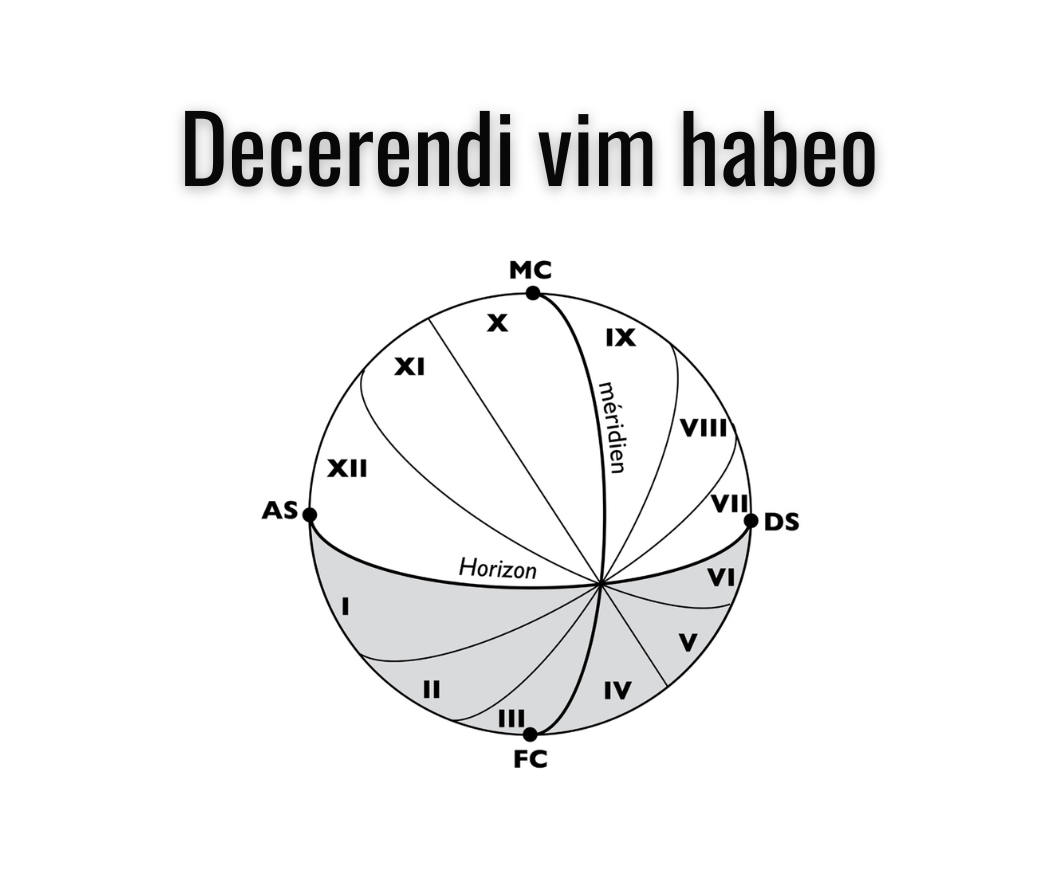Perché è importante la suddivisione in 12 case celesti? Perché questo permette di dare una certa qualità e forza agli astri presenti nei diversi luoghi celesti. La ripartizione in 12 luoghi celesti permette di stabilire immediatamente la forza o la debolezza degli astri nella loro capacità operante ed operativa.
Gli astrologi greci hanno diviso i dodici luoghi celesti in due grandi gruppi.
Il primo gruppo è chiamato “luoghi operosi” (chrêmatistikoi) dove gli astri hanno maggiore capacità di compimento e di espressione, i loro significati si prestano ad essere manifestati. Questi luoghi sono quelli angolari (casa uno, casa dieci, case sette, casa quattro), quelli in trigono all’oroscopo (casa nove e casa cinque) e quelli in esagono all’ascendente posti sopra l’orizzonte (casa undici).
L’altro gruppo è chiamato “luoghi inoperosi” (achrêmatistikoi) oppure luoghi di pigrizia e sono quelli disgiunti ovvero non relazionati all’oroscopo (privi di aspetti tolemaici all’ascendente, per intenderci; casa tre perché pur formando un esagono all’oroscopo è sotto l’orizzonte, casa due, casa otto, casa dodici, casa sei). Nei luoghi pigri gli astri sono meno capaci di esprimere sé stessi, sono in un certo senso più lenti e significano anche ciò che tende ad essere nascosto, o meno evidente.
Il concetto greco di operosità (chrêmatizein) ha il suo corrispondente concetto latino ovvero decerendi vim habeo (colui che ha potere di decidere). Non è utilizzato solo per le questioni connesse ai luoghi celesti, ma intende identificare quei pianeti che possono avere capacità di deliberare giudizi. Per esempio, potremmo dire che Venere in casa undici è “chrêmatistikoi” perché in luogo succedente è capace di esprimersi rispetto a una Venere in case sei che è “achrêmatistikoi” ovvero incapace di esprimersi perché è in una casa cadente. Ma allo stesso modo possiamo dire che il pianeta eletto ad Hyleg di una genitura è chrêmatistikoi perché capace di esprimere una funzione, di esplicitare una azione sulla natività.
La divisione in 12 case celesti è quella che chiamiamo domificazione. Tolomeo non indica esplicitamente il modo che aveva di domificare. Tuttavia, nel Libro Tre della Tetrabiblos, capitolo Durata della Vita, scrive che il decimo luogo è composto dai trenta gradi posizionati presso il culmine superiore, per poi continuare a descrivere gli altri luoghi parlando sempre di settori composti da 30 gradi. L’Almagesto sempre di Tolomeo dichiara esplicitamente che ciascun quadrante contiene un arco di equatore di 90 gradi e semiarchi di ampiezza variabile, ciascun quadrante è di 6 ore temporali. Quello che indica Tolomeo è il principio della tripartizione dei quadranti, che segue quindi un principio temporale, basato sulla divisione del moto diurno. Ne consegue che anche Tolomeo divideva il cielo con una suddivisione temporale, che è quella che abbiamo imparato a rintracciare nel sistema placido, che risponde chiaramente ai principi tolemaici.
ESISTE UNA DOMIFICAZIONE MIGLIORE DELLE ALTRE?
Sono tanti i modi con cui possiamo dividere le 12 case celesti. Per esempio, la suddivisione delle case celesti secondo il sistema chiamato Whole Sign Houses WSH (termine coniato tra l’altro da Robert Hand, e che è traducibile come case a segno intero) non è un sistema di domificazione testimoniato esplicitamente da Tolomeo. Al contrario, Tolomeo nel suo Almagesto pare indicare una suddivisione temporale come indicato in precedenza. Già questo ci indica che presumibilmente la domificazione proposta da Tolomeo è quella temporale, e non quella spaziale, tantomeno quella mista; il moto diurno degli astri è di estrema importanza nella congettura finale. Il sistema placidiano è il sistema che più di tutti rispetta le indicazioni di Tolomeo riportate nel suo Almagesto per quanto riguarda la ripartizione temporale dei quadranti ricavati dall’arco equatore, e dai relativi semiarchi. Ma al di là di quello che può o potrebbe aver pensato Tolomeo, il sistema di divisione placidiano è quello che più di tutti rispetta il moto diurno degli astri, un moto con cui ci relazioniamo più frequentemente, anche inconsapevolmente, nell’osservazione delle luci del cielo.
NOTA FINALE – La suddivisione in 12 luoghi può seguire un criterio spaziale, oppure temporale, oppure misto. La suddivisione secondo le ore diurne notturne appartiene sicuramente a Placido, che ha sistematizzato la questione nella domificazione placidiana. Tuttavia già Tolomeo nell’Almagesto ne parla, trattando la suddivisione dello spazio locale attraverso i decreti dei quadranti, che avviene attraverso non i gradi eclittici ma attraverso quelli equatoriali. La domificazione placidiana è quella che più di tutte ci dà una realtà oraria degli astri, a differenza della domificazione WSH che invece ci rimanda una idea spaziale forse più utile in casi geografici estremi (dove abbiamo latitudini geografiche tali che certe luci del cielo…. non tramonteranno mai).
TRADUZIONE IN INGLESE
Why is the division into 12 astrological houses so important? It is important because it allows us to give the stars present in the various celestial places a certain quality and strength. The distribution in 12 astrological houses allows us to immediately establish the strength or weakness of the stars in their operating and operative capacity.
Chrêmatistikoi VS Achrêmatistikoi
The Greek astrologers divided the twelve astrological houses into two large groups. The first group is called “operative places” (chrêmatistikoi), where the stars have a greater capacity for fulfilment and expression, and their meanings lend themselves to being manifested. These are the angular houses (house one, ten, seven and house four), those in trine to the horoscope (house nine and five) and those above the horizon forming a hexagon with the ascendant (house eleven).
The other group is called the “inoperative places” (achrêmatistikoi) or places of idleness, and they are houses detached or unrelated to the horoscope (in other words, lacking Ptolemaic aspects in the ascendant; house three, which, although it forms a hexagon with the horoscope, is below the horizon, house two, house eight, house twelve and house six). In the idle places, the stars are less able to express themselves, they are in a sense slower, and their meanings tend to be hidden or less obvious.
The Greek concept of operativity (chrêmatizein) has its corresponding Latin concept: decerendi vim habeo (the one with power to decide). It is not only used for matters related to the astrological houses, but is meant to identify those planets that may have a capacity to resolve judgements. For example, we could say that Venus in house eleven is “chrêmatistikoi” because in the succedent house it is able to express itself, unlike Venus in houses six, which is “achrêmatistikoi” or incapable of expressing itself because it is in a “idle” (cadent) house. In the same way, we can say that the planet chosen as the Hyleg of a geniture is chrêmatistikoi because it is able to express a function, to express an action on the birth.
The division into 12 astrological houses is what we call domification. Ptolemy does not explicitly indicate his method of domification. However, in Book Three of the Tetrabiblos, in the chapter on Length of Life, he writes that the tenth house is composed of the thirty degrees positioned in the culmination, and then continues to describe the other houses, always talking about sectors composed of 30 degrees. However, Ptolemy’s Almagest also explicitly states that each quadrant contains an equatorial arc of 90 degrees and semi-arcs of variable amplitude (each quadrant of 6 temporal hours). What Ptolemy indicates is the principle of the tripartite division of the quadrants, which therefore follows a temporal principle, based on the division of the diurnal motion. It follows that Ptolemy also divided the sky with a temporal subdivision, which is the one we have learned to trace in the placidus system, which clearly corresponds to Ptolemy’s principles.
For those who practice astrology questions inevitably arise regarding the abundant material we have from history and which we have only started to reassess and reconsider in recent decades. However, it is also very dangerous to come to absolute or hasty conclusions. For example, the division of the astrological houses according to the Whole Sign Houses (WSH) system (a term coined by Robert Hand) is not a domification system explicitly mentioned by Ptolemy. On the contrary, in his Almagest, Ptolemy seems to indicate a temporal subdivision, as already mentioned. This already clearly shows us that Ptolemy proposed a temporal domification, not a spatial one, and much less a mixed one. The Whole Sign Houses system does not show us the temporal reality of the stars, which does not mean that it is a faulty system, but simply that it does not take the temporal aspect into account; the diurnal motion of the stars is of extreme importance in the final conjecture. The Placidus system is that which most closely follows the indications given by Ptolemy in his Almagest concerning the temporal distribution of the semi-arcs and the arc of the equator.



